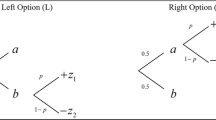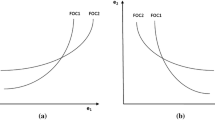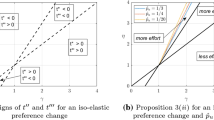Summary.
What are the determinants of the optimal level of effort to reduce the probability of a loss to occur? Whereas most of the literature on this question focused on risk aversion, we show that the concept of prudence (i.e., a positive third derivative of the utility function) is essential to answer this question. We explain in this paper that prudence and prevention tend to be opponents rather than allies contrary to the intuition attached to everyday language.
Similar content being viewed by others
Author information
Authors and Affiliations
Corresponding author
Additional information
Received: 7 November 2003, Revised: 3 August 2004,
JEL Classification Numbers:
D61, D81.
Correspondence to: Christian Gollier
Rights and permissions
About this article
Cite this article
Eeckhoudt, L., Gollier, C. The impact of prudence on optimal prevention. Economic Theory 26, 989–994 (2005). https://doi.org/10.1007/s00199-004-0548-7
Issue Date:
DOI: https://doi.org/10.1007/s00199-004-0548-7




